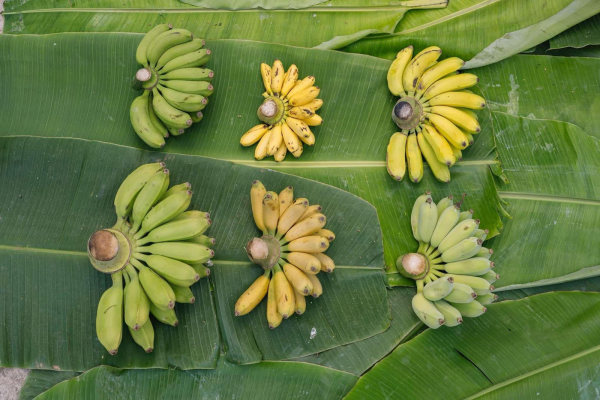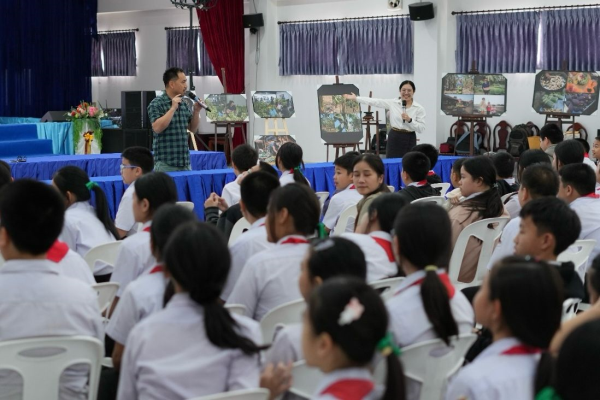KPL
Southeast Asia is the cradle of bananas and the world’s largest banana producer, and the Lao PDR is no exception. Laos is home to an impressive variety of banana species — far beyond the well-known Kuay Nam (lady fingers) and Kuay Ngao (Cavendish) bananas commonly found in local markets.

(KPL) Southeast Asia is the cradle of bananas and the world’s largest banana producer, and the Lao PDR is no exception. Laos is home to an impressive variety of banana species — far beyond the well-known Kuay Nam (lady fingers) and Kuay Ngao (Cavendish) bananas commonly found in local markets.
There are still many local banana varieties being grown, but many - especially the younger generation - are unaware of their rich diversity in Laos and nutritional value. Consumers only recognize a few commercial banana varieties, while other edible bananas remain unknown, undervalued, and at risk of extinction.
Why bananas matter for the Lao PDR?
There is so much more to bananas than just a sweet snack. They are one of the most nutritious, affordable, and versatile fruits available in the Lao PDR. Rich in potassium, fibre, vitamins, and minerals, bananas provide a healthy energy boost and are an essential part of a balanced diet. Beyond the fruit, almost every part of the banana plant can be used — from the leaves used in Lao traditions such as Baci ceremony, to the flowers and stems featured in animal feeding, traditional dishes and natural remedies, every part of the banana plant has a purpose.

While bananas are extremely tasty and useful, they are often underappreciated. The lack of awareness and emergence of new banana diseases are a threat both to the country's banana biodiversity and to food security in the future.
The Ban Lao Project:
To address this challenge, the Ban Lao Project was launched with the financial support of the French Embassy in Lao PDR. Project goals include preserving Lao banana diversity while promoting better nutrition for the younger generation.
Through interactive learning activities, the project encourages students to discover the diversity, importance, and benefits of bananas — aiming to reconnect them with this humble but vital fruit.
Between 31 March and 3 April 2025, the Ban Lao Project team in partnership with the Faculty of Agriculture from the National University of Laos, visited four schools in the suburbs of Vientiane Capital - Virathavone Secondary School, Mayouli School, Sengsamai School, and Xaypanya School. More than 350 students and teachers learned about banana diversity and the nutritional value of this local fruit as part of the project's awareness campaign.
“The activity was a meaningful and enriching experience for our students and teachers. From the photo exhibition to the creative painting contest, the activities offered a perfect blend of education and inspiration,” said Mr. Minou Monmalichanh, School Advisor, Xaypanya School.

“Through the Ban Lao Project, we aim to reconnect young people in the Lao PDR with the country’s rich banana diversity — not only as a nutritious and affordable local fruit, but as part of their cultural identity. With support from the French Embassy, we’re proud to work closely with schools and the young generation to raise awareness about banana biodiversity, healthy eating, and sustainable agriculture,” said Mr. Hoa Tran Quoc, agronomist from CIRAD.
The next step of the Ban Lao Project is to bring together the worlds of bananas and sports — this time, through the game of badminton. Following the Lao New Year celebrations, the project will organise a lively event in Vientiane: the Badminton Tournament and Banana Learning Day. This special day will combine fun and learning, featuring a range of engaging activities such as a banana-themed photo exhibition, interactive presentations, educational games, and quizzes designed to spark students’ curiosity. To top it off, there will be a banana tasting session, showcasing creative dishes made from various Lao banana varieties, prepared by both Lao and French chefs.
With these efforts, the project hopes to ensure that Lao banana varieties thrive, contributing to better nutrition, sustainable agriculture, and preserving cultural identity for years to come. Please stay tuned!
KPL